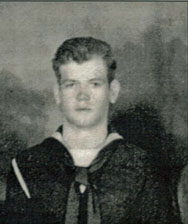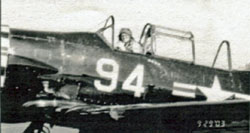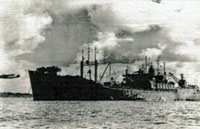Arnim L. Harris

Arnim Harris Jr. joined the United States Navy in September of 1943. He was stationed in Jacksonville, Florida, trained as an airplane mechanic and assigned to the USS Tangier (AV-8) at the end of World War II. The crew of the USS Tangier was likely experienced in the ways of war by this time, having had the distinction of surviving the Japanese attack at Pearl Harbor.
His work with airplanes, no doubt, sparked an interest and while in the Navy, Mr. Harris learned to fly, taking his first lesson on October 1, 1944. This began a lifelong association with aviation.
After his discharge from the Navy, Mr. Harris work for Cavalier Aviation as a crop duster as well as for Aero Industries as a flight instructor and charter pilot.
An interesting story is that, he would fly over the home of his best girl, Betty Brock, and dropnotes making arrangements for dates. Apparently that won Betty’s heart because they later married and raised a family of five children. In 1952, Arnim was the pilot for the Commanding General of the Corps of Engineers based in Richmond and in October 1953, he began employment with Eastern Airlines. During his many years of association with Eastern Airlines he was promoted to the position of Captain.

While employed with the airline, Captain Harris, in addition to probably being a wide variety of aircraft was also the Chief Accident Investigator for the Airline Pilots Association. He also served as the Air Safety Committee Chairman. In addition to being awarded the Airline Pilots Association International “Pilot of the Year” in 1979, he was appointed Chairman of the Cockpit Design Committee for the Boeing 757 in the 1980’s. Captain Harris retired from Eastern Airlines in 1985 and was #1 ranked Captain with over 35,000 flying hours. To the left is Captain Harris flying in celebration of this 80th birthday at Hanover Airport.
Captain Arnim L. Harris Jr. was recently inducted into the Virginia Aeronautical Historical Society Hall of Fame.
Post note: Captain Harris is not the first of his family to hold the title of Captain. He has traced his ancestry back to Captain Thomas Harris, early settler of Henrico County from the time of Sir Thomas Dale who held the first recorded patent for property known as Longfield, later to become Curles Neck.
>Back to Top<
USS Tangier, September 2007

USS Tangier (AV-8): The USS Tangier, first of a class of three 11,760-ton seaplane tenders, was launched at Oakland, California in 1939 as the merchant ship Sea Arrow. Taken over by the Navy 1940, she remained at her builders’ for conversion work and went into full commission in August 1941.
Note a PBY patrol seaplane flying past below the bow and a seaplane on the aft deck in the far right of the photo.
Tangier went to Pearl Harbor in November and was employed supporting the expanded force of patrol seaplanes based there during a time of increasing tension with Japan. She was present during the December 7, 1941 air raid on Pearl Harbor and was slightly damaged when a Japanese bomb exploded nearby.
When the Japanese attacked Pearl Harbor on December 7, 1941, USS Tangier was moored astern of the USS Utah (AG-16). That ship was torpedoed and sunk, and the nearby seaplane tender Curtiss (AV-4) was hit by a bomb and a crashing enemy plane. However, Tangier’s only damage, from a bomb near-miss, was superficial. Her guns actively engaged Japanese planes, claiming to have shot down three, and also fired on an enemy midget submarine subsequently sunk by the destroyer Monaghan (DD-354). She also took part in rescue efforts during and after the attack.
About a week later, Tangier was sent toward Wake Island with supplies for its Marine garrison, but was recalled when Wake was captured by Japanese forces on December 23. In February 1942, the tender steamed to the South Pacific, where she stayed until June, maintaining seaplane patrols out of Noumea, New Caledonia. Her planes played a supporting role in the May 1942 Battle of the Coral Sea.
Following a West Coast overhaul, Tangier again was based in the South Pacific in February-August 1943, then served on transport duty between the war zone and the United States. From March 1944 until June 1945, the ship's base moved steadily forward from Australia to the Philippines as her seaplanes assisted the Seventh Fleet and General MacArthur's forces during their advance across New Guinea and northward.
Tangier was receiving the attentions of a statewide shipyard when the Pacific War ended in August 1945, but was sent back to the Far East to support occupation efforts from October 1945 into March 1946. She then made the long trip back to the US, passing through the Panama Canal and arriving at Norfolk, Virginia in late April. The next month, she began deactivation at Philadelphia, Pennsylvania. Tangier decommissioned there in February 1947 and remained in the Atlantic Reserve Fleet until 1961. In November of that year she was sold for scrapping.
(Reprinted from Naval Historical Center website.)
>Back to Top<
The Virginia Aeronautical Historical Society
The idea for the society was fostered by Morten W. Lester, a well-known Virginia aviation enthusiast from Martinsville, who saw the need to preserve and display rapidly disappearing aviation artifacts in Virginia. Lester soon found other Virginians who shared his vision to establish a Virginia Aeronautical Historical Society. On November 30, 1977, that vision became a reality when the Virginia Aeronautical Historical Society was launched by a group of interested Virginia citizens. The Society is permanently headquartered in the Virginia Aviation Museum at the Richmond International Airport.
The original purpose of the organization was to “study, research, interpret, preserve, and disseminate Virginia's aviation and aeronautical heritage, and to preserve, acquire, and display those items pertaining to Virginia’s aviation and aeronautical heritage”.
The objectives of the Virginia Aeronautical Historical Society are to:
1. Prepare, collect, and preserve documents, aircraft, aerospace vehicles, and other items which relate to the history of aviation and aerospace in Virginia, from its beginning to the present
2. Educate the general public with emphasis on young people, on the contribution which Virginia has made and is making to the development in aviation and aerospace;
3. Provide aid and support to the Virginia Aviation Museum and those Virginia institutions; and
4. Promote aviation in Virginia.
To support the mission, the Virginia Aeronautical Historical Society operates and directs a number of programs.
- The Virginia Hall of Fame: one of the most successful projects sponsored by the Virginia Aeronautical Historical Society-the Hall of Fame-was created to honor Virginians who have made significant contributions to the development of aviation. New inductees are honored at an annual Hall of The Dinner hosted in November of each year.
- Historical Marker Program: Virginia is the site of many aviation firsts and one of the projects of the VAHS is to commemorate those sites with roadside historical markers. Working in conjunction with the Virginia Department of Transportation, a number have already been erected around the state commemorating such events as the first ship-to-shore flight, the first passenger flight, the first later-than-air flight in North America, and the unfortunate notice of the first aviation passenger fatality. Many other firsts are also on record in efforts are continuing to expand the number of these markers around the state.
- Oral History Project: so as not to be lost forever, the oral history program is the designed to interview and record the stories of Virginia's aviation pioneers and others instrumental in the state’s aeronautical advancement.
- Airport History Project: Virginia is the location of one of the earliest and many of the most important airports in the nation.
To commemorate these significant airports the society has published a book entitled Virginia Airports-A Historical Survey of Airports and Aviation from the Earliest Days by Vera Roster Rollo, PhD and Norman L. Crabill. To purchase this very informative 252 page book or for questions relating to the Society call the office at (804)222-8690 or e-mail vahs@smv.org.
(Reprinted from the VAHS website)
>Back to Top<
Oral History Histories: Arnim L. Harris - USS Tangier
Allen Gardner-GI Bill | Robert Hawkes, Sr. & Jr. | Alonzo Hyatt Kelly |
Welford Williams-Bronze Star | All Oral Histories
Home | Henrico | Maps | Preservation | News | Membership | Shopping | HCHS
|











